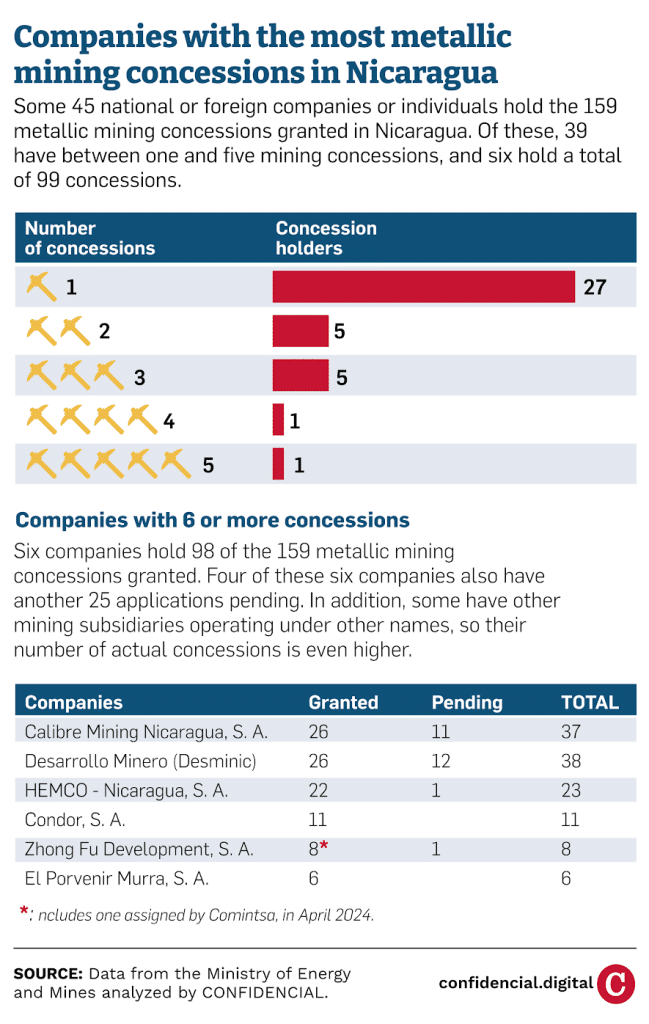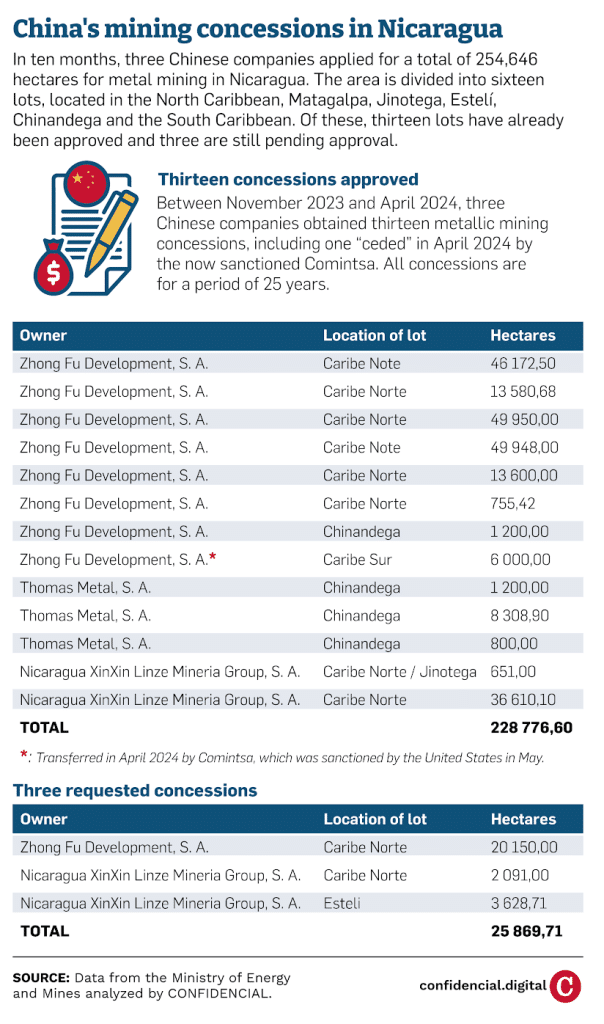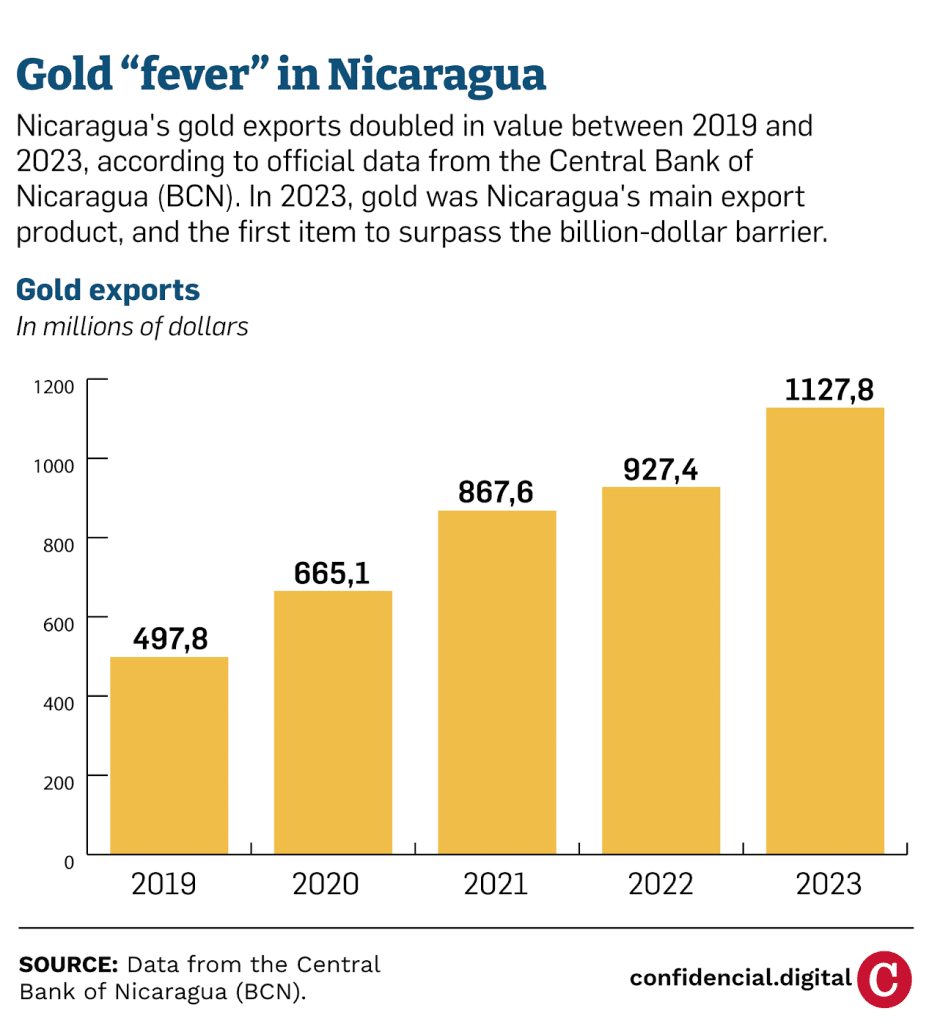China Seeks Gold in Nicaragua, Receives 13 New Concessions

In six months, three Chinese companies have received 13 mining concessions, one of them a “lifeline” for the sanctioned Comintsa
HAVANA TIMES – China is gaining large areas for metal mining in Nicaragua at an accelerated pace, with the “blessing” of the dictatorship of Daniel Ortega and Rosario Murillo. In six months, between October 2023 and April 2024, three Chinese companies have received thirteen mining concessions. The sum of these thirteen lots granted is equivalent to 11.66% of the total number of hectares granted for metallic mining in Nicaragua, according to official data from the Ministry of Energy and Mines (MEM), analyzed by CONFIDENCIAL.
Concessions to Chinese mining companies have also been expeditious. All of them were approved between two to eight months after being requested.
The thirteen lots granted to Chinese companies are distributed in nine municipalities in Nicaragua. Eight are located in the North Caribbean Coast Autonomous Region (RACCN) and are part of a municipality in Jinotega. Another four lots are in the department of Chinandega, and one more is in the Autonomous Region of the South Caribbean Coast (RACCS). In addition, three other applications are pending: two in the North Caribbean, and a third in the department of Estelí.
Three Chinese companies in charge of thirteen mining concessions
The thirteen metallic mining lots in Nicaragua, granted to China, are in the hands of three companies: Zhong Fu Development S.A., Thomas Metal S.A., and Nicaragua XinXin Linze Minera Group S.A.
Each mining concession is valid for 25 years, and the three companies have exclusive rights to explore, exploit, and establish beneficiation plants to process mining materials.
Zhong Fu Development, “lifeline” of the sanctioned Comintsa
Zhong Fu Development, S. A. is the Chinese company with the most metallic mining concessions in Nicaragua. On February 28, 2023, this company requested eight lots located in the North Caribbean and the departments of Chinandega and Jinotega from the Ministry of Energy and Mines.
On October 10, the Santo Tomás concession was approved, located between the municipalities of Cinco Pinos and Santo Tomás del Norte, in Chinandega. Twenty-one days later, on October 31, another six of the eight concessions requested were authorized: Columbus I, Kuikuinita I, Mulukukú, Puerto Cabezas, Siuna, and Waslala. In other words, seven of the eight concessions were approved in less than eight months, although the certifications were published on November 11 and December 20 in the Official Gazette La Gaceta.
Zhong Fu Development, S.A. also stands out among the Chinese mining companies because it obtained the transfer of a concession from Compañía Minera Internacional, S.A. (Comintsa), less than a month before the U.S. Treasury Department sanctioned it.
On April 17, 2024, the MEM authorized the transfer of the Tutuwaka lot in the El Rama municipality, in the South Caribbean of Nicaragua, granted in May 2022 to Comintsa. Less than a month after this transfer, on May 15, Comintsa was sanctioned by the United States.
According to the Treasury Department, Comintsa “is owned and operated” by Salvador Mansell Castrillo, holder of the Energy and Mines portfolio, sanctioned by the Treasury Department in November 2021.
“Gold is Nicaragua’s main commodity export, and this action (the sanction) is intended to degrade the Ortega-Murillo regime’s ability to manipulate the sector and benefit from Comintsa’s corrupt operations,” assured the Treasury Department, which also sanctioned the company Capital Mining, which it pointed out of being “an intermediary in the gold sector controlled by Laureano Ortega Murillo and Mansell Castrillo.”

The meteoric rise of Zhong Fu Development
With the transfer of the 6,000 hectares of the Tutuwaka lot previously held by Comintsa, Zhong Fu Development, S. A. now has eight lots for metallic mining in Nicaragua, with a total extension of 181,206 hectares. The lots are located in the municipalities of Siuna, Mulukukú, Waslala, Waspam, and Puerto Cabezas, in the North Caribbean; El Rama, in the South Caribbean; and Villanueva, Cinco Pinos and Santo Tomás del Norte, in Chinandega.
In addition, the company is inthe process of approving a 20,150-hectare lot, located in Waspam, from the list it submitted in February 2023.
Zhong Fu Development, S. A. is registered in the Public Property Registry of Managua with the registry account MC-XFZRH1, and according to the MEM, it has the technical and financial capacity to develop mining activities in the country. The company is legally represented by Feiwu Bian, a foreign businessman with residency and domicile in Nicaragua, according to publications in the Official Gazette La Gaceta.
In less than a year, Zhong Fu Development has become the Chinese company with the most mining concessions in Nicaragua, and has also become one of the five largest mining companies in the country, only below the “veterans” Calibre Mining Nicaragua, S.A., of Canadian capital; Desarrollo Minero (Desminic), the Colombian company Hemco – Nicaragua, S.A. and the British company Condor, S.A.

Thomas Metal’s Expedited Mining Concessions
The company Thomas Metal, S.A., represented by the Chinese citizen Xiangming Gu, appeared for the first time in the Nicaraguan mining business on September 27, 2023. On that day it applied for the concession of the Wonderful Gold lot, located in the Villanueva municipality of Chinandega, in the western part of the country. The MEM authorized the concession less than two months later, on November 24, showing the speed of the regime for extractive projects.
Less than a month later, on December 1 and 20, Thomas Metal, S.A., applied for two more mining concessions: the Carambola and Dragón Rojo lots, also in the department of Chinandega. The authorizations took three months. One was granted on March 15 and the other on March 20.
MEM only pointed out that, in the case of the Carambola concession, 0.32 hectares are located within the buffer zone of the Estero Real Delta Natural Reserve, and therefore excluded that area from the concession.
Thomas Metal’s three metallic mining concessions total 10,308 hectares, all in the municipality of Villanueva, Chinandega. According to the resolutions of the Ministry of Energy and Mines, the company must allow access and artisanal mining work to the people who were already established and doing this activity within the concession area.
In Villanueva, hundreds of villagers have been working for decades as güiriseros in the hills of this municipality, where they have put aside agriculture and cattle ranching to dedicate themselves to artisanal mining in search of gold. For over five decades, they have worked in small groups or cooperatives. Now it remains to be seen how they will coexist with the Chinese mining company.
Most recent: Nicaragua Xinxin Xinxin Linze Mining Group, S.A.
Nicaragua Xinxin Linze Mining Group, S.A. is the Chinese company that has been operating in Nicaragua for the shortest time. However, it has received more than 37,000 hectares for exploration and mining.
On October 9, 2023, the Chinese mining company applied for the following lots: Chinotega -located between San José de Bocay, Jinotega, and Siuna, in the North Caribbean- and Caribe, located in the north of the region of the same name. Five months later, on March 15, 2024, MEM granted the concession for the 651-hectare Chinotega lot. However, the certification was not published until the beginning of May in the Official Gazette La Gaceta.
While waiting for a response, on November 13, 2023, Nicaragua Xinxin Linze Mining Group applied for a third lot: Nuevo Bijagual, of 36,610.1 hectares, located between the municipalities of Siuna and Mulukukú, in the North Caribbean. The Nuevo Bijagual concession was approved three months later: on February 27, 2024, although the certification was not published until the end of April.
The two concessions approved for Nicaragua Xinxin Linze Mining Group total 37,261 hectares. In addition, the Caribe lot of 2091 hectares and a fourth lot of 3628 hectares called El Guaylo, in the municipality of San Juan de Limay, in Estelí, are still pending approval.
One-fifth of Nicaragua under mining concessions
As of May 2024, there are more than 1.96 million hectares in Nicaragua granted for metallic mining exploitation. Of these, 11.66% have been granted to the three Chinese mining companies between October 2023 and April 2024.
Another 758,776 hectares requested by various companies and individuals are pending approval, bringing the area granted for metallic mining to more than 2.72 million hectares. A total equivalent to 20.88% of Nicaragua’s surface area, estimated at 13,037,300 hectares.
In addition, 54,664.72 hectares are approved for non-metallic mining, and there are 11,414.89 hectares pending approval for this same sector. This smaller amount brings the total number of hectares requested for mining of any type in Nicaragua to over 2.78 million hectares, of which over 2.01 million have already been approved, with more than 97% of these hectares for metallic mining.
In Nicaragua, exports from the mining industry, mainly gold, are on the rise. Between 2019 and 2023, the amount of gold exports grew by more than 226.5%, according to official data from the Central Bank.
In China, the “hunger” for gold is also growing unstoppably. Through gold, Beijing is betting on diversifying its reserve funds. The People’s Bank of China was the largest buyer of gold from the official sector in 2023, with purchases of 7.23 million ounces, according to the World Gold Council, and the trend continues to rise. In April 2024, the bank added 60 000 troy ounces to its reserves, leading gold purchases for the eighteenth consecutive month.
That demand is also pushing the price of gold above its all-time highs. This year the cost of each troy ounce has already broken the record of 2330 dollars.
China also “buys gold” from other companies
The environmentalist and president of the illegalized Fundación del Río, Amaru Ruiz, maintains that the management of mining concessions in Nicaragua has been “quite discretional”. He denounces that in several cases, the environmental studies are unknown and the affected communities have not been consulted.
In addition, he warns that the companies that obtain the concessions “are not necessarily” the same ones that extract the metals. For this reason, he maintains that there is an “under-registration” of the Chinese mining companies operating in Nicaragua.
“We know that there are Asian intermediaries buying gold in concessions that are granted to another company. That is why I say that there is a nebula in the process of granting concessions”, comments the environmentalist.
However, he considers that the presence of Chinese businessmen in the mining business in Nicaragua does not yet represent “a reconversion” of the market, although he does warn that their introduction is part of the dictatorship’s strategy to evade the sanctions imposed by the United States.
Before the sanctions against Comintsa and Capital Mining, the United States had already sanctioned, in October 2022, the General Directorate of Mines, attached to the Ministry of Energy and Mines. Likewise, the then president of the Board of Directors of the Nicaraguan Mining Company (Eniminas), General Ramón Humberto Calderón Vindell, in January 2022, and the Minister of Energy and Mines, Salvador Mansell Castrillo, in November 2021.
“We have seen this phenomenon as a result of the sanctions established to the mining sector,” assures Ruiz. “It is evidently an interest in increasing the gold trade markets, and from there has generated the interest of some companies, especially Asian ones, to enter the sector to establish a level of commercialization and openness to the Asian market”, he estimates.
Concerns about low environmental standards
In addition to the speed of the regime to approve concessions to Chinese companies, the environmentalist is concerned that the environmental and labor requirements are lower than the standards applied by other mining companies.
“In the case of China, it is historically known that its environmental and labor standards are very low. This raises concerns about the impact they may have on the environment and also on the people involved in this company,” says Ruiz.
As of the publication of this report, neither the Ministry of Energy and Mines nor the Ministry of Environment and Natural Resources (Marena) or the Chinese companies have published the environmental studies that should be carried out prior to the execution of the project, according to the General Environmental Law.
Mining industry exported almost US$1.16 billion in 2023
In 2023, the mining industry in Nicaragua registered US$1158.6 million, according to official figures from the Central Bank of Nicaragua (BCN). These exports are mainly of the golden metal. Gold became Nicaragua’s first export item in 2023 and the first to cross the billion dollar barrier in a single year.
With this total, the mining industry grew 22.4% compared to 2022, when it exceeded 946.6 million dollars.
The same BCN details that this increase is driven by increases in gold (+200.4 million dollars; 21.6%) and silver (+12.9 million dollars; 83.3%) exports, as a result of increases in average contracted prices and exported volumes.

Gold “fever” in Nicaragua
Mining concessions in Nicaragua grant exclusive rights for the exploration, exploitation and establishment of profits on mineral deposits for a period of 25 years, which can be extended for a similar period. All these attractive conditions did not go unnoticed by the mining companies of the Asian giant, and their accelerated pace and “blessed” by the Ortega dictatorship in Nicaragua.





